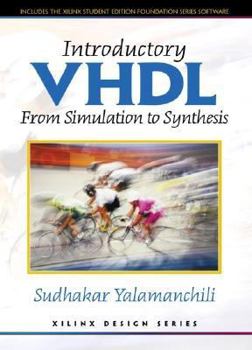Introductory VHDL: From Simulation to Synthesis
Select Format
Select Condition 
Book Overview
This book focuses on presenting the basic features of the VHDL language in the context of its use for both simulation and synthesis. Basic language concepts are motivated by familiarity with digital... This description may be from another edition of this product.
Format:Paperback
Language:English
ISBN:0130809829
ISBN13:9780130809827
Release Date:July 2000
Publisher:Pearson
Length:432 Pages
Weight:1.85 lbs.
Customer Reviews
3 ratings
Clear concepts in concise description
Published by Thriftbooks.com User , 19 years ago
I have found the book so helpful after trying to find answers on line or from other VHDL books. It helped me greatly in understanding the concepts, some times assisted by the just in-time figures. For example the concept of 'delayed(T) signal attribute has been clearly explained and even illustrated with a Figure. We can not only use the signal to assign another one, but also more importantly we can "check for relationships between the current value of the signal and an older value of the same signal". This has helped me to understand some professional VHDL programs. The author must be such a knowledgeable professor who can teach the concepts so clearly as well. Thanks for the book!
Overall, good book for begineers.
Published by Thriftbooks.com User , 21 years ago
had to buy this book for subject at uni. The arena of VHDL, digital logic, synthesis, simulation and FPGA's is a broad subject and it can be hard to know where to start and where to find the right information. Overall I found the book to be a good introductory text and reference but with a few small annoying features.This book is definitely at the begineer's level. The really good feature of this book is the focus on synthesis of VHDL code. If you are learning VHDL from what vendors publish and what is on the internet you may not find what you need. Chapter 7 especially will fill in the missing pieces and give you a good idea of what is going on with things such as synthesis compiliers. Haven't seen any other texts that explain that kind of thing.Some items that let the book down for me was that it seemed to be riddled with textual errors. Numerous times there seemed to be words missing from sentences, which really interrupts the flow of learning. The other part that was frustrating was that the tone the author took seemed to be like an adult talking to a baby. However, he proves his point and I can understand the motivation for doing so, as VHDL is not a normal programming language. The book covers FPGA's (indirectly) and the author shows to reference elements in an FPGA if needed, whilst still sticking to the whole VHDL theme. That is something that I found good. Something I believe that would have been helpful would be having the simulation software on the CD, with an appendix overview of what is going on with those tools. If you are an undergraduate, new to VHDL and are new to using EDA software like Xilinx and don't quite follow everything, then this book will get you going quickstart. It can help save you alot of potential time being wasted.
Overall, good book for begineers.
Published by Thriftbooks.com User , 21 years ago
had to buy this book for subject at uni. The arena of VHDL, digital logic, synthesis and simulation is a broad subject and it can be hard to know where to start and where to find the right information. Overall I found the book to be a good introductory text and reference but with a few small annoying features.This book is definitely at the begineer level. The really good feature of this book is the focus on synthesis of VHDL code. If you are learning VHDL from what vendors publish and what is on the internet you may not find what you need. Chapter 7 especially will fill in the missing pieces and give you a good idea of what is going on with things such as synthesis compiliers. Haven't seen any other texts that explain that kind of thing.The items that let the book down is that the book seemed to be riddled with textual errors. Numerous times there seemed to be words missing from sentences and it really interrupts the flow of learning. The other part that was frustrating was that the tone the author took seemed to be like an adult talking to a baby. However, he proves his point and I can understand the motivation for doing so, because VHDL is not a normal programming language. Something that I believe would have been helpful to others would be having the simulation software on the CD with an appendix overview of what is going on with those tools. If you are an undergraduate, new to VHDL and are new to using EDA software like Xilinx and don't quite follow everything, then this book will get you going quickstart. It will help to minimise the distance between the two topics of FPGA's and VHDL, which can save you an enormous amount of wasted time.






